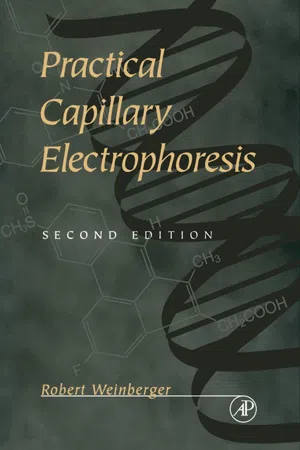
- 462 pages
- English
- ePUB (mobile friendly)
- Available on iOS & Android
Practical Capillary Electrophoresis
About This Book
In the 1980s, capillary electrophoresis (CE) joined high-performance liquid chromatography (HPLC) as the most powerful separation technique available to analytical chemists and biochemists. Published research using CE grew from 48 papers in the year of commercial introduction (1988) to 1200 in 1997. While only a dozen major pharmaceutical and biotech companies have reduced CE to routine practice, the applications market is showing real or potential growth in key areas, particularly in the DNA marketplace for genomic mapping and forensic identification. For drug development involving small molecules (including chiral separations), one CE instrument can replace 10 liquid chromatographs in terms of speed of analysis. CE also uses aqueous rather than organic solvents and is thus environmentally friendlier than HPLC. The second edition of Practical Capillary Electrophoresis has been extensively reorganized and rewritten to reflect modern usage in the field, with an emphasis on commercially available apparatus and reagents. This authoritative and very comprehensible treatment builds on the author's extensive experience as an instructor of short courses for the American Chemical Society and for industry.
- Illustrated with detailed diagrams of electrophoretic phenomena
- Offers step-by-step methods development schemes
- Presents techniques for developing quantitative, robust, and precise methods
- Includes an extensive troubleshooting guide
- Updates and greatly expands on the first edition-more than 50% of the text is new
- Written by an internationally recognized scientist who is an instructor for American Chemical Society short courses on HPCE
Frequently asked questions
Information
Table of contents
- Cover image
- Title page
- Table of Contents
- Copyright
- Dedication
- PREFACE TO THE SECOND EDITION
- PREFACE TO THE FIRST EDITION
- MASTER SYMBOL LIST
- Chapter 1: Introduction
- Chapter 2: Capillary Zone Electrophoresis: Basic Concepts
- Chapter 3: Capillary Zone Electrophoresis: Methods Development
- Chapter 4: Capillary Zone Electrophoresis: Secondary Equilibrium, Micelles, Cyclodextrins, and Related Reagents
- Chapter 5: Capillary Isoelectric Focusing
- Chapter 6: Size Separations in Capillary Gels and Polymer Networks
- Chapter 7: Capillary Electrochromatography
- Chapter 8: Injection
- Chapter 9: Detection
- Chapter 10: Putting It All Together
- INDEX